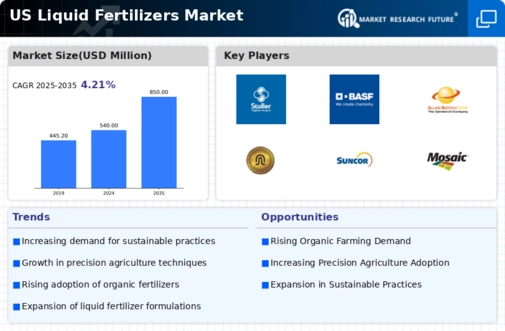Government Support and Subsidies
Government initiatives aimed at promoting sustainable agriculture practices are significantly impacting the liquid fertilizers market. Various federal and state programs provide financial assistance and subsidies to farmers who adopt environmentally friendly practices, including the use of liquid fertilizers. For instance, the USDA has allocated substantial funds to support the adoption of innovative agricultural technologies, which includes liquid fertilizers. This financial backing encourages farmers to invest in high-quality liquid fertilizers, thereby enhancing crop yields and soil health. The potential for increased productivity, coupled with government incentives, suggests a favorable environment for the growth of the liquid fertilizers market in the US.
Rising Demand for Organic Produce
The increasing consumer preference for organic produce is driving the liquid fertilizers market. As more consumers seek out organic fruits and vegetables, farmers are compelled to adopt organic farming practices, which often require liquid fertilizers that meet organic standards. According to the USDA, the organic food market in the US has seen a growth rate of approximately 10% annually, indicating a robust demand for organic farming inputs. This trend suggests that liquid fertilizers formulated for organic agriculture are likely to experience heightened demand, thereby influencing the overall dynamics of the liquid fertilizers market. The shift towards organic farming not only supports environmental sustainability but also enhances soil health, further propelling the liquid fertilizers market.
Increased Crop Yields and Food Security
The pressing need to enhance food security in the US is a critical driver for the liquid fertilizers market. As the population continues to grow, the demand for higher crop yields becomes paramount. Liquid fertilizers play a vital role in achieving this goal by providing essential nutrients that promote plant growth and development. According to the USDA, the average yield of corn, a staple crop, has increased by approximately 20% over the past decade, largely due to advancements in fertilizer technology, including liquid formulations. This trend indicates that the liquid fertilizers market is likely to expand as farmers seek effective solutions to meet the rising food demand while ensuring sustainable agricultural practices.
Technological Innovations in Fertilizer Production
Technological advancements in the production of liquid fertilizers are reshaping the market landscape. Innovations such as enhanced nutrient delivery systems and the development of slow-release formulations are becoming increasingly prevalent. These technologies not only improve the efficiency of nutrient uptake by plants but also reduce environmental impact. The liquid fertilizers market is witnessing a shift towards more sophisticated products that cater to the specific needs of various crops. As farmers become more aware of the benefits of these innovations, the demand for technologically advanced liquid fertilizers is expected to rise, potentially leading to a more competitive market environment.
Environmental Regulations and Sustainability Initiatives
The growing emphasis on environmental sustainability is influencing the liquid fertilizers market. Stricter regulations regarding fertilizer application and nutrient runoff are prompting farmers to adopt more sustainable practices. Liquid fertilizers, particularly those that are formulated to minimize environmental impact, are gaining traction as a result. The US Environmental Protection Agency (EPA) has implemented guidelines aimed at reducing nutrient pollution, which encourages the use of liquid fertilizers that align with these regulations. This shift towards environmentally friendly products not only supports compliance with regulatory standards but also enhances the reputation of farmers, thereby driving the liquid fertilizers market.























Leave a Comment